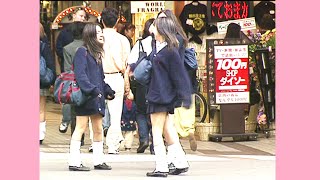Heisei Retro Boom: Loose Socks, Instant Cameras, and Sticker Swaps Return

On the streets of Sapporo, high school students are embracing the fashion that once defined their parents’ teenage years. “Loose socks and Heisei-era gyaru fashion are so emotional and cool!” said one enthusiastic second-year student. Inspired by old family photos, many teenagers find the once-popular style “cute” and are eager to make it their own.
The revival extends beyond fashion. Beloved characters like Tamagotchi and Angel Blue, which were hugely popular among girls in the late 1990s and early 2000s, are reappearing on new merchandise. “Things I couldn’t buy as a child are now available, and I’m happy I can finally get them as an adult,” shared a 28-year-old fan.
Other nostalgic items such as platform shoes and early digital cameras with their iconic low-resolution images are also making a comeback. Young people today appreciate these for their unique aesthetic, which evokes a sense of nostalgia.
The Heisei era, spanning roughly three decades, was the birthplace of many iconic trends—from gyaru fashion to Tamagotchi toys and collectible card games. Today, these symbols are being rediscovered and celebrated under the banner of “Heisei retro.”
According to researcher Mero Yamashita, who has collected more than 40,000 Heisei-era items, the renewed interest comes from both those who experienced the era firsthand and a new generation discovering it for the first time. “People who grew up during Heisei now have disposable income, so they’re buying the things they once wanted as kids. Meanwhile, younger people who never knew those trends are discovering them from a neutral perspective and buying what they find cute,” explained Yamashita.
Retailers are responding enthusiastically to this trend. A store that opened in June 2025 in Hokkaido features a dedicated “retro corner” stocked with nostalgic products, including classic gaming consoles. Among the most popular items are stickers, which were once a staple of schoolyard trades and games. These often sell out immediately.
“Some customers buy them for nostalgia, but many just want to collect again. People in their 20s and 30s, as well as children, are all buying them,” said Kazunori Miura of Don Quijote’s Chitose branch.
The sticker craze, especially popular among girls during the Heisei years, has exploded once again. Puffy, three-dimensional character stickers have become bestsellers in 2025, with 160,000 units sold in September alone—and even higher sales expected in October.
“I love trading stickers. Collecting the puffy ones and swapping for the ones I want is fun,” said a 9-year-old girl. Parents and children are enjoying this hobby together, often choosing nostalgic designs like “water stickers.”
Moreover, iconic brands such as Angel Blue and Love and Berry, which were originally popular more than a decade ago, are experiencing a resurgence. New product lines have launched to meet the growing demand.
Yamashita notes that the current wave of Heisei retro trends is especially driven by items that were beloved by girls who were in elementary school during the 2000s—from character merchandise to sticker exchanges.
In addition to fashion and merchandise, loose socks are trending once again among high school students. Likewise, the distinctive low-resolution look of instant film cameras is now admired for its nostalgic charm, rounding out a multifaceted revival of the Heisei era’s cultural touchstones.
https://newsonjapan.com/article/147275.php








